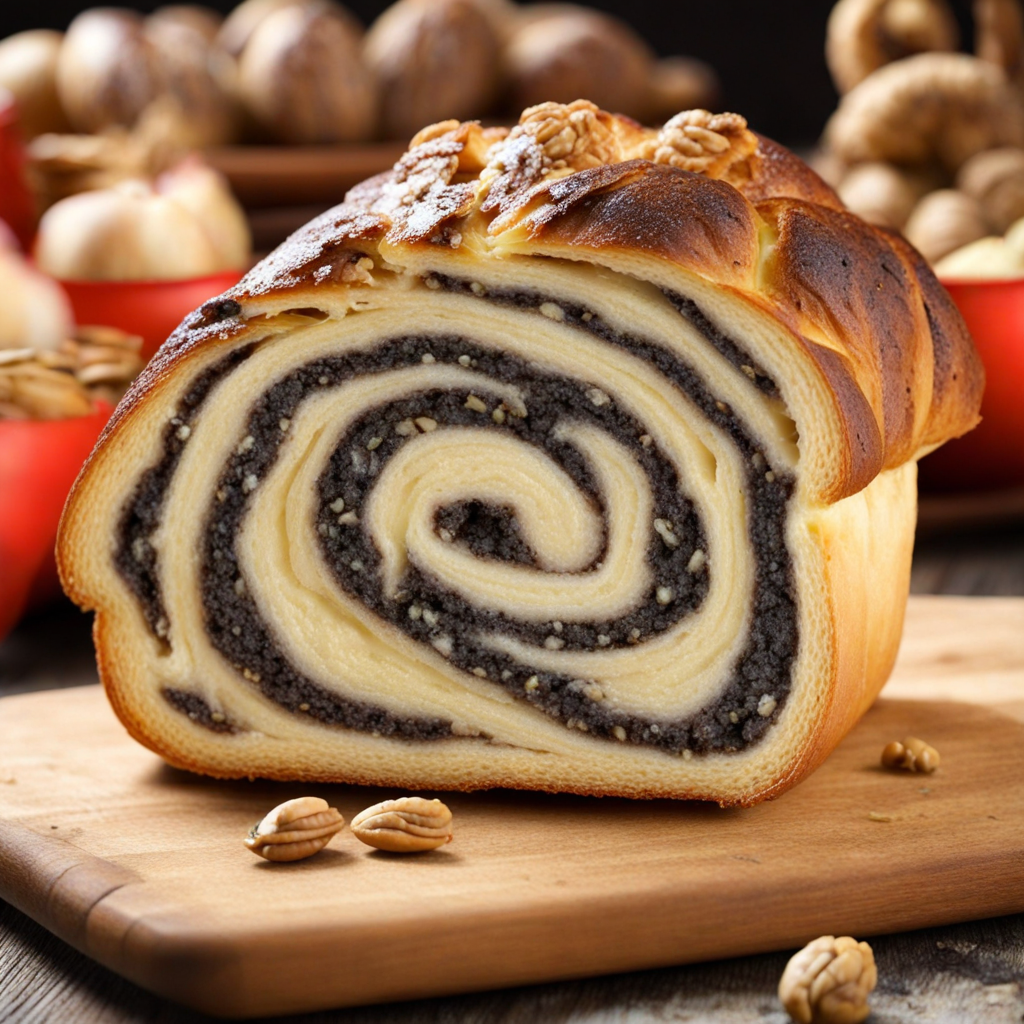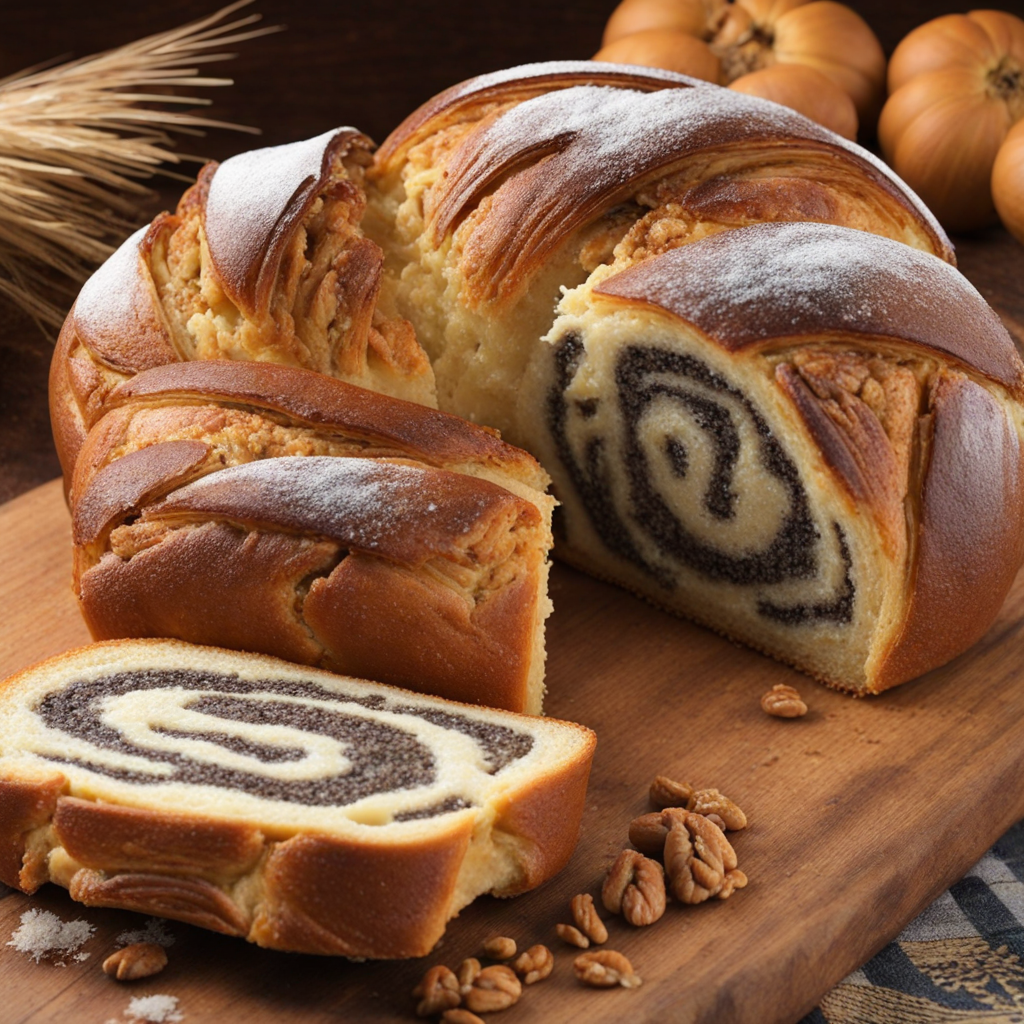Cozonac
Cozonac is a traditional Romanian sweet bread that embodies the rich culinary heritage of the region. This delightful treat is typically enjoyed during festive occasions, particularly around Christmas and Easter, but its irresistible flavor makes it a beloved snack year-round. The dough is a labor of love, made with flour, milk, sugar, eggs, and butter, resulting in a rich and slightly sweet base that is both soft and fluffy. The preparation of Cozonac is a time-honored process, often involving families gathering together to share in the experience of kneading the dough and waiting for it to rise, adding a sense of community to the enjoyment of this delicious bread. What truly sets Cozonac apart is its decadent filling, which can vary widely but often includes a blend of ground walnuts, cocoa powder, and sugar, or sometimes a mixture of poppy seeds. The filling is generously swirled into the dough, creating a beautiful marbled effect once baked. Some recipes also incorporate raisins or other dried fruits for added texture and sweetness. The result is a visually stunning loaf that offers a delightful contrast between the soft, airy bread and the rich, flavorful filling, making each bite a heavenly experience. Upon baking, Cozonac develops a golden-brown crust that invites you in with its sweet, warm aroma. When sliced, it reveals its intricate swirls, and the first bite is a perfect harmony of flavors and textures. The sweetness is balanced with the nutty richness of the filling, while the bread itself is moist and tender. Whether enjoyed plain, with a smear of butter, or paired with a cup of coffee or tea, Cozonac promises an unforgettable taste of Romanian culture, making it a must-try for anyone looking to explore new culinary delights.
How It Became This Dish
Cozonac: The Sweet Bread of Romanian Heritage Cozonac, a traditional Romanian sweet bread, is much more than just a culinary delight; it is a symbol of cultural heritage, family gatherings, and festive celebrations. Rich in flavors and history, this delectable bread pulls together various strands of Romania's past, from its ancient roots to its modern-day significance. #### Origins: A Bread with Ancient Roots The origins of cozonac can be traced back to the ancient peoples of the region, where various forms of bread-making were practiced long before the arrival of Christianity. The word "cozonac" itself is believed to derive from the Latin "cocis," which means "to bake" and reflects the bread's deep-seated association with baking traditions across Europe. Cozonac is thought to have evolved from the Byzantine bread-making practices, infused with local customs and ingredients. The Greeks and Romans brought their knowledge of baking and fermentation to the Danube region, influencing the way bread was made. The introduction of sugar, nuts, and spices transformed simple bread into a festive treat. Over time, cozonac became associated with significant events and celebrations, especially during the Christmas and Easter holidays. #### Cultural Significance: A Bread for Celebrations Cozonac holds a special place in Romanian culture, often prepared for major religious holidays and family gatherings. Its intricate preparation and presentation make it a centerpiece during festive meals. In many households, baking cozonac is a cherished tradition passed down through generations, symbolizing family bonds and continuity. The bread is typically filled with a variety of sweet mixtures, the most popular being a blend of ground walnuts, cocoa, and sugar. Other variations include fillings of poppy seeds, Turkish delight, or even sweet cheese. Each family may have its own recipe, with some choosing to add a hint of rum or vanilla for added depth. This personalization reflects the regional diversity within Romania, with different areas having their distinct styles and flavors. During Christmas, cozonac is often prepared and shared among family and friends, embodying the spirit of generosity and love. It is customary to offer a slice to guests as a gesture of hospitality. Similarly, at Easter, the cozonac is blessed in church and served as part of the festive meal, symbolizing the joy of resurrection and renewal. #### Development Over Time: From Tradition to Modernity Throughout history, cozonac has undergone various transformations, adapting to changing tastes and societal influences while maintaining its core identity. In the 19th century, as Romania began to modernize, the introduction of new baking techniques and equipment allowed for greater experimentation with ingredients and methods. The Industrial Revolution brought about advances in milling, which made flour more accessible and affordable, leading to an increase in home baking. In the early 20th century, cozonac became a staple in Romanian bakeries, with professional bakers beginning to craft their own versions. This commercialization led to the emergence of specific regional styles, such as the cozonac from Oltenia, known for its generous walnut filling, or the sweeter, richer versions found in Transylvania. The post-World War II era saw cozonac become a symbol of resilience and comfort during times of hardship, as families would still find joy in the act of baking together even when resources were scarce. The fall of communism in 1989 marked another turning point for cozonac. As Romania opened up to the world, traditional recipes began to blend with international baking trends. The new era brought about a revival of interest in artisanal techniques, leading to a resurgence of traditional baking methods. Bakeries now offer both classic and innovative versions of cozonac, incorporating flavors and ingredients inspired by global cuisine while keeping the essence of the traditional recipe intact. #### Contemporary Cozonac: A Global Love Today, cozonac is not only a cherished Romanian dish but has also gained recognition beyond the country's borders. Romanian expatriates and immigrants bring their recipes to countries around the world, sharing the joy of cozonac with new communities. In places with significant Romanian populations, such as the United States, cozonac can be found in specialty bakeries, often enjoyed during holiday seasons by both Romanians and those curious to try this sweet bread. Social media has played a significant role in revitalizing interest in traditional recipes. Food bloggers and influencers showcase their unique takes on cozonac, from vegan adaptations to gluten-free versions, making the recipe accessible to a broader audience. The resurgence of home baking, particularly during the COVID-19 pandemic, has reignited interest in cozonac as people sought comfort in familiar traditions. #### Conclusion: The Legacy of Cozonac Cozonac is more than just food; it is a living testament to Romania’s cultural history and the bond between past and present. Every bite of cozonac tells a story of tradition, family, and resilience, bridging generations and transcending borders. As it continues to evolve, cozonac remains a symbol of celebration, embodying the warmth of home and the spirit of togetherness. Whether enjoyed during festive occasions or as a special treat on a quiet afternoon, cozonac invites us to appreciate the simple joys of life, reminding us of the power of food to connect us to our roots and to one another. As long as families gather to bake and share this sweet bread, the legacy of cozonac will endure, nourishing both body and soul for generations to come.
You may like
Discover local flavors from Romania







